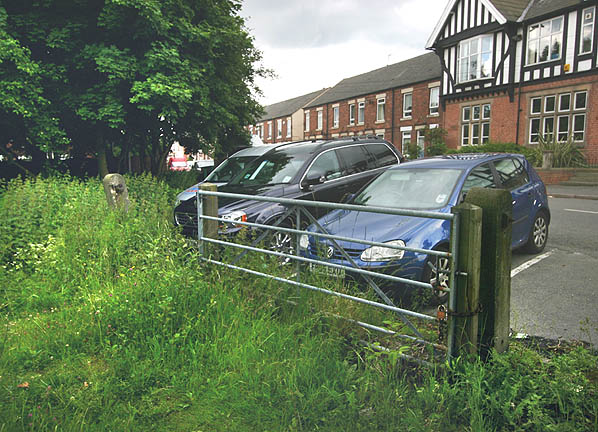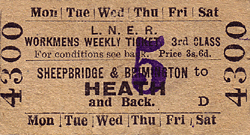
Station Name: HEATH
|
| Date opened: | 2.1.1893 |
| Location: | East side of Devonshire Terrace |
| Company on opening: | Manchester, Sheffield and Lincolnshire Railway |
| Date closed to passengers: | 4.3.1963 (Excursions till 6.5.1963) |
| Date closed completely: | 12.6.1965 |
| Company on closing: | British Railways (Eastern Region) |
| Present state: | The station has been demolished, the station forecourt can still be seen in Devonshire Terrace with two railway gate posts still in place. The stationmaster's house is now in private occupation. |
| County: | Derbyshire |
| OS Grid Ref: | SK435661 |
| Date of visit: | 16.6.2008 |
Notes: The railways first came to Heath to transport coal from a number of collieries in the vicinity notably Holmewood Colliery immediately south of the station which was served by a loop off the main line and Williamthorpe Colliery to the north west of the station. Coal traffic was always the major revenue earner and the passenger services were of relatively minor importance. With the decline in passenger traffic after WW2 Heath closed when the local service on the Great Central was withdrawn on 4th March 1963 although special excursions continued to call at the station until 6th May 1963. Freight traffic was maintained until 12th June 1965 with a private siding remaining in use after that date.
The last freight trains ran through the station in 1966 and track lifting began in December 1967. A public footpath now runs through the station site. The road bridge to the north of the station has now been rebuilt and now spans a road to an industrial estate on the site of Holmewood Colliery. BRIEF HISTORY OF THE GREAT CENTRAL RAILWAY BETWEEN SHEFFIELD AND LONDON In 1854, Edward Watkin became General Manager and then in 1864 chairman of the Company. Watkin's ambition was to build a rail link between the industrial heartland of Manchester and Sheffield, south to London and through a tunnel beneath the channel to reach Paris and the expanding markets of Continental Europe.
In the 1890's the MS&LR began construction of its 'Derbyshire Lines', in effect the first part of its push southwards. Leaving its east - west main line at Beighton Junction, some 5 1/2 miles east of Sheffield, the line headed south through the Nottingham coal field with a branch line serving its new Central Station in Chesterfield. In July 1890 the MS&LR obtained another act to extend from Chesterfield to Heath creating a loop line. Work started on this new section, of some 4¾ miles, before construction on the original line was finished and opened in July 1893.
Due to its late construction, the company was able to take advantage of the latest technology including steam excavators. It was heavily engineered with viaducts and wide cuttings with a maximum gradient of 1 in 128; there were no sharp curves or level crossings which would ensure a fast service for both passengers and freight. Most of the stations on the ‘London extension’ were built to a standard design consisting of an island platform with the booking office located on the platform. All the stations were built on an embankment or in a cutting adjacent to a road bridge, with access via stairs from the middle of the bridge; only the larger intermediate stations like Rugby and Loughborough had street level buildings. Because Edward Watkin also expected his trains to reach Europe through a channel tunnel, the line was also built to a larger continental (Berne) loading gauge. The Great Central opened for coal traffic on 25 July 1898, for passenger traffic to a new terminus at Marylebone on 15 March 1899 and for general goods traffic on 11 April 1899. The new line was built from Annesley in Nottinghamshire to join the existing Metropolitan Railway which had now reached Quainton Road in Buckinghamshire, where the line became joint Met/GCR owned (after 1903), it returned to GCR metals near Finchley Road for the final section into Marylebone. In 1903, new rails were laid parallel to the Metropolitan Railway from Harrow to the junction north of Finchley Road, enabling more traffic to use Marylebone. Although the new line had now reached London, Edward Watkin was unable to fulfil his ambition as he was forced to retire through ill health.
In the 1923 grouping, the Great Central became part of the London & North Eastern Railway which brought an increase in freight traffic from the south Midlands and south west England but the LNER's main north - south route was into London Kings Cross so the Great Central was always considered as a secondary route. After nationalisation, the line became part of British Railways Eastern Region but was transferred to the London Midland Region in 1958. By this time the service was already in decline with the increasing popularity of the car and it was unable to compete with other north - south routes as the line passed through sparsely populated areas south of Rugby. Manchester to London express services were withdrawn on 2nd January 1960 leaving only three semi-fast trains a day and it came as little surprise when the line became the first main line to close in the Beeching era. Beeching considered that the Great Central was a duplicate route which could be sacrificed in favour of the Midland main line.
In 1968 the London Railway Preservation Society chose Quainton Road as its new base, the society being renamed as the Quainton Railway Society; this has now developed into the Buckinghamshire Railway Centre covering 25 acres. The Centre boasts one of the largest private railway collections in the country with numerous steam locomotives, many housed in the former listed trainshed from Oxford Rewley Road which was dismantled and rebuilt at Quainton Road in 1999/2000. The shuttle service between Nottingham and Rugby lasted until 3rd May 1969. As closure approached a group of railway enthusiasts got together to discuss the possibility of buying a section of the track to operate preserved steam locomotives. A steam service was reinstated between Loughborough and Quorn in 1973 and in 1976 Charnwood Borough Council agreed to purchase the land from BR and lease it to the railway for 99 years. Despite a shaky start, the Great Central Railway PLC are now operating throughout the year between their headquarters at Loughborough Central and a new station called Leicester North just inside the city boundary. The remaining track between Leicester - Rugby was lifted in early 1970.
The NTHC's aim was to reinstate the remaining line into Loughborough where it joins the GCR
With our motorway network now working at capacity there have been a number of proposals to reopen other sections of the Great Central main line and in 2006 Central Railway was formed to look into the feasibility of building a new rail link from central England to the Channel Tunnel which would include rebuilding part of the Great Central route south of Rugby reviving a 1990’s government proposal to reopen that section of the line as part of a fast rail link from Scotland to the Channel Tunnel. Preservation group web sites: The Buckinghamshire Railway Centre, The Great Central Railway (steam service between Loughborough and Leicester North) & Nottingham Transport Heritage Centre (steam service between Ruddington and Loughborough) Selected other web sites: The Transport Archive contains further detailed history of the Great Central plus a vast collection of 2344 'on line' photographs many ( the Newton Collection) taken during the construction of the London Extension. Chris Ward's Annesley Web site featuring numerous photographs of the Great Central around Nottingham and the Annesley Motive Power Depot. Great Central Railway through Leicester. Nigel Tout's web site with numerous photographs of the Great Central remains around Leicester and a series of archive photographs of the line. Bridging the Gap details ongoing work to reinstate the link between the two preserved lines. The Great Central Railway Society promotes an historical interest in the Great Central Railway. Selected further reading: Great Central Memories by John MC Healey published 1987 by Baton Transport ISBN 0 85936 193 4 - heavily illustrated history of the London Extension. Great Central Then and Now by Mac Hawkins - published (2nd edition) by BCA 1992 ISBN 0 7153 9326 X , station by station photographic survey of the Great Central between Sheffield and London with numerous 'then and now' photographs. See also Sheepbridge & Brimington Station and construction of the Manchester, Sheffield and Lincolnshire Railway through Brimington by Philip Cousins. Published in St. Michael & All Saints, Brimington parish magazine. (Click here for full text). Tickets from Michael Stewart & Glynn Waite. Route map drawn by Alan Young. Too see other stations on the Great Central Railway between Sheffield Victoria and Aylesbury click on the station name: Aylesbury, Waddesdon, Quainton Road (1st site), Quainton Road (2nd site)**, Calvert, Finmere, Brackley Central, Helmdon, Culworth, Woodford Halse, Charwelton, Braunston & Willoughby, Rugby Central, Lutterworth, Ashby Magna, Whetstone, Leicester Central, Leicester North***, Belgrave & Birstall, Rothley**, Swithland****, Quorn & Woodhouse**, Loughborough Central**, East Leake, Rushcliffe Halt**, Ruddington, Ruddington Factory Halt, Arkwright Street, Nottingham Victoria, Carrington, New Basford, Bulwell Common, Bulwell Hall Halt, Hucknall Central, Annesley South Junction Halt, Hollinwell & Annesley, Kirkby Bentinck, Tibshelf Town, Pilsley, Staveley Central, Renishaw Central, Killamarsh Central, Beighton (1st site), Beighton (2nd site), Woodhouse Junction, Woodhouse*, Darnall*, Sheffield Victoria & Sheffield Bridgehouses. |
old1.jpg)

5.jpg)


Photo by Nick Catford
Click on thumbnail to enlarge

|
| Last updated: Sunday, 21-May-2017 11:05:46 CEST | © 1998-2008 Disused Stations |


 In 1893 the MS&LR obtained Parliamentary approval to extend this line to London (known as the ‘London Extension’. Construction of the 92 mile route started in 1895 and on 1st August 1897 the company changed its name to the Great Central Railway; it was the last 'main line' to be built until the Channel Tunnel rail link in 2003.
In 1893 the MS&LR obtained Parliamentary approval to extend this line to London (known as the ‘London Extension’. Construction of the 92 mile route started in 1895 and on 1st August 1897 the company changed its name to the Great Central Railway; it was the last 'main line' to be built until the Channel Tunnel rail link in 2003.





 Home Page
Home Page